Designing fantasy armor for your characters can be an awful lot of fun. But you may run into difficulties when it comes to the practicalities.
Below, we’ll take a look at the armor found in the fantasy genre, covering everything from chain mail to helmets. And we’ll dip back in time to look at medieval armor and how it was used and crafted.
We all love a character with a cool set of fantasy armor: the baresark Rek from David Gemmell’s Legend with his enchanted coat of bronze, or Tomas from Raymond Feist’s Riftwar Cycle with his gleaming white dragon plate which gifted him incredible power.
Although such armor exists in fantasy worlds, it’s important to understand how things work in the real world, even at a basic level. For fantasy stories to be more believable, we need to understand how it interacts with our characters, especially if they’re enchanted.
So below, we’ll take a look at the relationship between the genre of fantasy and medieval armor. We’ll cover everything from helmets and plate armor to chainmail.
The aim is to arm you with what you need to enrich your tales with brilliant detail. We’ll also take a look at female fantasy armor and those used by knights, potential designs, and ways to help you find inspiration for creating your own.
To navigate your way through this guide, just click the links below.
Choose A Chapter
- The Fantasy Genre And Medieval Armor
- Chain Mail
- Plated Armor
- Helmets
- Other Types Of Armor
- The Medieval Knight
- Fantasy Armor Examples
- Where To Buy Fantasy Armor
- Get More Writing Support From Fellow Fantasy Writers
- More Resources On Fantasy Armor
The Fantasy Genre And Medieval Armor
The fantasy genre borrows an awful lot from medieval history. Perhaps it’s because the genre was born out of stories that emerged from the Middle Ages like Beowulf and King Arthur (around the 10th-11th century).
As such, the contemporary tales that have followed, like Lord of the Rings, Game of Thrones, Dungeons and Dragons and everything in between, have paid homage to that era.
So it’s unsurprising to see soldiers wielding swords and axes and shooting bows. As we’ll see below, medieval armor developed through necessity—people needed to protect themselves from those wicked blades and needle-sharp darts.
We therefore see in the fantasy genre characters equipped with grand helmets and beautiful pieces of plate armor. Game of Thrones/A Song Of Ice And Fire is one series that wonderfully explores fantasy armor and weapons.
As we’ll see below, one of the best things about using medieval armor in a fantasy story is the freedom to elevate it in some way. You could introduce magical enchantments or ability-granting traits.
Let’s take a look at some individual pieces of armor.
Chain Mail
Mail was one of the first types of metal armor developed, arguably by the Celts, though other sources say its origins came from Eastern Europe.
A coat of mail was a complex web of metal rings, each locked with an iron rivet. Such coats were made from brass or iron, though steel was deemed best due to its toughness.
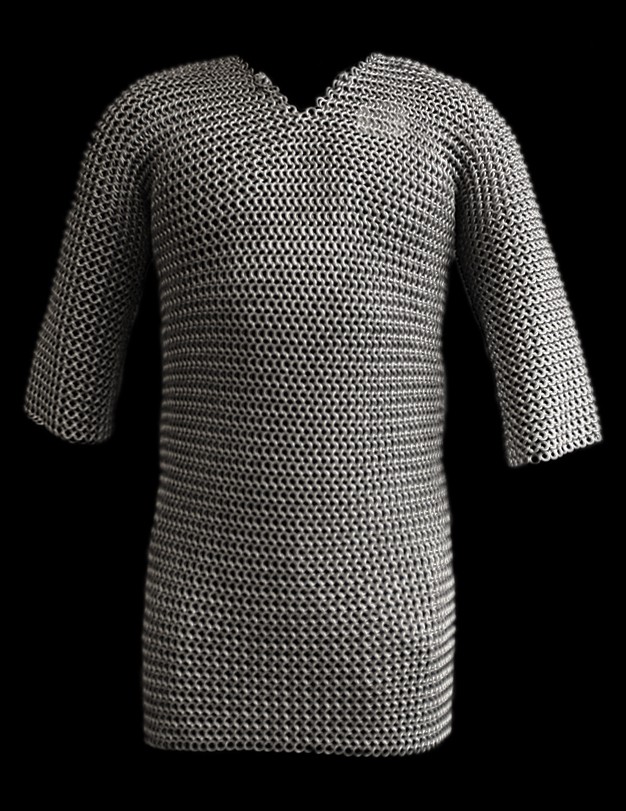
A coat of mail
A jacket or coat of mail was usually worn with a hood, or coif, of the same material to protect the head and neck.
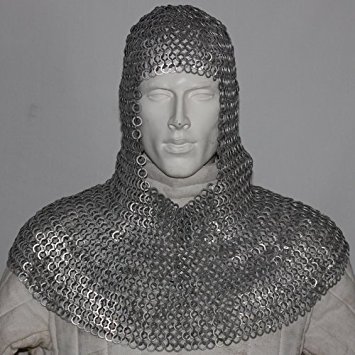
A chain mail coif
As time marched on, small plates of leather or iron were added to the mail to protect key areas, such as vital organs.
Mail was particularly effective against glancing blows. In battle, you are trying to strike a moving target, so mail was sufficient as most blows were glancing ones. Clean, powerful strikes were needed to disable a foe wearing mail. Blunt weapons were effective, causing haemorrhaging and concussion, so padded garments known as a doublet or gambeson were worn underneath to provide added protection.
Mail was lightweight and flexible. Good for the mobile knight. It was pretty easy to make, though laborious, and easy to repair. Another benefit to chain mail, a point which can slip the mind of writers, is that it was cheap and efficient, able to accommodate different-sized warriors, unlike expensive plated armor.
Chain mail is a great piece of fantasy armor to use in your stories purely because of its flexibility. From lowly serfs to great warriors, all could wear and fight effectively in chainmail.
Plated Armor
Most picture the knight when we talk about plated armor—rigid tin men that can withstand all manner of blows. Something like this:
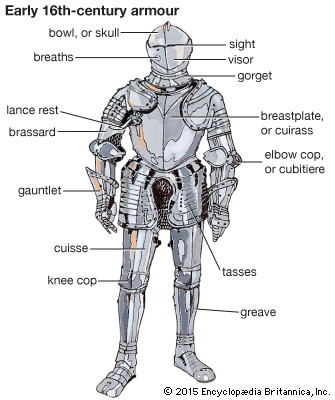
Armor of a knight
As you can see, a knight’s armor is made up of a lot of different pieces. It took a while to get ready, with the help of somebody else needed, usually squires, who began with the feet and worked up from there.
Both doublets and chain mail were worn in conjunction with plated armor for that added protection, particularly for areas plate could not cover, such as arms and the groin.
Coats of plated armor soon came about, which consisted of a series of plates linked on top of one another. They could withstand high-velocity strikes from a javelin or lance, driven home by somebody charging forwards on horseback. Only the most powerful strikes could pierce such armor. They looked something like this:
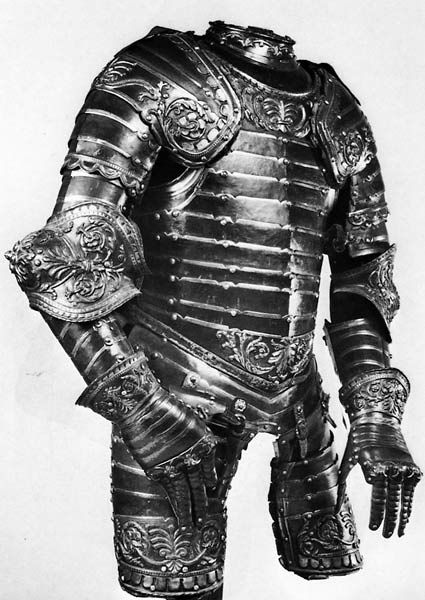
A coat of overlapping plates
One of the main defensive strengths of plated armor came from its curved design, which deflected both blades and arrows. As with mail, steel was the best material due to its hardness, which was obtained by heating the steel to extreme temperatures and then submerging it into cold water, a process known as ‘quenching. You may have seen steelworkers doing this after forging the likes of blades and horseshoes.
Once quenched, the steel was re-heated to make it more resilient. Heating to the perfect temperature was key. In pre-thermometer times this was difficult as you can imagine, so instead, armorers observed the colour of the heated steel. When heated, steel turns from yellow, to brown, to blue, to red. Once blue, it is quenched a second time, permanently fixing its hardness. Arrows will bounce off steel crafted in such a way—unless from close range, as we discussed last week.
Wearing a suit of armor was like being in your own private world. The senses were deadened: sight limited, sound muffled, breathing stifled (depending on the type of helmet). It would have been extremely warm too. But it provided an odd sense of security. Fully geared up, you were a walking fortress.
Can you imagine tweaking this to make your own set of fantasy armor? Imagine your own armored knights storming through the battlefield like iron giants.
With all that armor, it’s often assumed the medieval knight was immobile. Not quite. Each suit was tailored to the individual. The aim was not to cause any impediment to movement. A warrior had to fight the enemy, and to fight his armor as well would be too distracting. The pieces around the vital organs—the chest and head—were thicker and heavier than those on the arms and legs to try and reduce weight as much as possible.
Armor, therefore, wasn’t that heavy—a full suit weighed approximately 50 pounds, which is around 3 to 4 stone. If a knight fell from a horse, he could quite easily pick himself up, not stuck on the ground like a tortoise knocked on its shell.
The appearance of armor was a big deal for knights. Chest plates had grand etchings. Pauldrons, gauntlets, and even leg armor were fashioned into elaborate designs.
And it’s in designs that you can really go wild with your own fantasy armor. We’ll come to this below.
Helmets
Helmets were arguably the most distinctive feature of an armored knight. Some had pointed snouts, the purpose of which was to deflect arrows when walking into arrow storms. The eye slits were narrow to prevent all sizes of arrowheads from finding their way through. Vision in such helmets was extremely limited, but this was the cost of added protection.
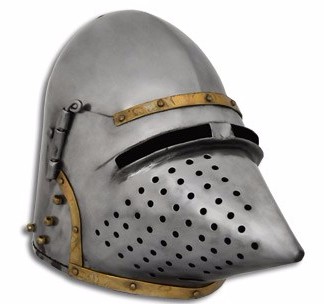
The front part of helmets, or the visors, were there to raise or open so the wearer could breathe during taxing hand-to-hand combat or scan around the battlefield.
Some helmets had chain attached which hung around and protected the neck, called an aventail, and most were padded inside, for added comfort. Who doesn’t like being comfortable when killing?

Aventail helmet
As with body armor, great efforts were made with the designs of helmets. Here are a few different types:
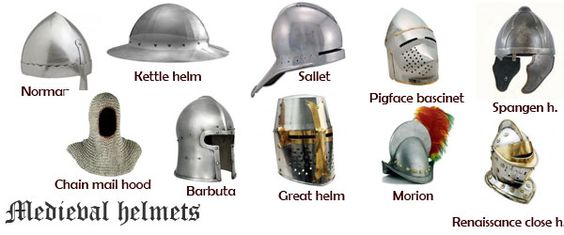
Other Types Of Armor
We mentioned gambesons above. These were worn on their own by those wanting greater speed and flexibility, but also by those unable to afford stronger armor. The padded material could absorb blows from blunt weapons and provided some protection from cuts, but against well-forged weapons they were useless.
Another type of cheap armor, one up from gambesons, was boiled leather, also known as cuir bouilli. Strips of leather were boiled in water, though some sources record oil and wax being used, and even animal urine. Reeking of piss on the battlefield was another weapon in the arsenal I suppose. Leather could be stitched into coats, or added to mail to provide added protection.
Adding these other bits of lesser-known fantasy armor to your stories can really add extra depth to your worldbuilding. It’s something readers definitely appreciate, which I found with Pariah’s Lament.
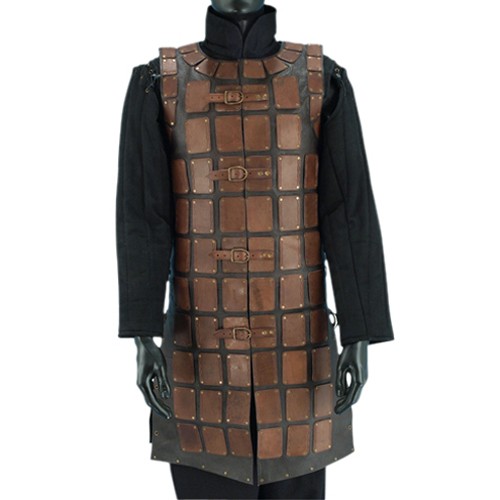
Celtic leather armor
Here’s a video showing the effectiveness (or ineffectiveness) of leather armor against arrows. Excuse the ‘on hold’ background music.
And let’s not forget the trusty steed. As knights became fully armored, so did their mounts. Some wore a trapper – a covering of full chain mail—and down the line, some horses even had their own plated armor. Expensive indeed, and heavy—stronger horses had to be bred to handle the weight.
The Medieval Knight
A knight, by definition, was a lord. A lowly one at that, but one very much capable of climbing the ladder.
This idea of knights becoming lords was introduced in England by William the Conqueror. The shrewd king essentially licensed out parcels of his land as rewards to his warriors in exchange for their military service. Added on top of that the condition that they had to supply him with soldiers too. Those warriors came from the people who lived on the lands under the watch of the knights.
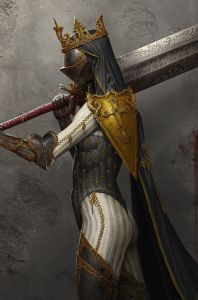
But they weren’t administrators. They were warriors first and foremost. And medieval warfare was a bloody affair. Blades hacking, slicing and puncturing, cutting open gaping wounds and severing limbs and heads from bodies. It’s hard to really appreciate just how sickeningly awful medieval warfare would have been.
And right at the heart of it were the leaders of society—the medieval lords.
Achieving glory in battle was one way of earning a knighthood. Continued successes could see knights rise higher up the ranks. William the Conqueror’s society was shaped with war in mind. Military service was always well-rewarded and violence applauded.
Richard the Lionheart, for instance, was celebrated amongst his peers for his ability to chop his enemy’s skulls down to the teeth. Knights were, indeed, hard to defeat in battle. At the end of the day, they were professional slayers, swords for hire. And if you were skilled at surviving and killing, it was a good way to make a living.
As a result, feudal England became rife with young murderous men. So as a way of trying to control them and their behaviour, the code of chivalry and honour was introduced. Think noble King Arthur and his knights of the roundtable. That was the theory. In reality, a medieval lord could pretty much do what they liked.
Further reading – How To Write Fight Scenes
Fantasy Armor Examples
I sincerely hope you’ve found some inspiration for your fantasy medieval armor.
It can genuinely be tough to come up with cool ideas for epic fantasy armor without drifting back to things that we’ve seen in the likes of Dungeons and Dragons, The Elder Scrolls and movies like Lord of the Rings. But I find looking back in time to the likes of the medieval period can provide some wonderful and unique ideas.
And what we’ve covered here today is only just the tip of the iceberg. Beyond medieval Europe, you have the Far East, the Romans, Viking… Before you know it you’ll have designed a full set of fantasy roman or viking armor.
Let’s take a look at some ways you can develop those unique ideas:
Knight Armor In Fantasy
In this section, we’ll take a look at some cool pieces of knight armor in fantasy that people have designed over the years, to give you even more inspiration for your own designs.
Here
‘s a fantastic image that Thomas Feichtmeir, AKA Cyangmou has put together. It illustrates brilliantly the differences between fantasy armor and the boring armor of reality, in this case, Gothic armor. For a bigger image, just click on the link above.
Female Fantasy Armor
And here are some great concepts for female fantasy armor.
To discover more awesome ideas, head over to Pinterest and just search for ‘female fantasy armor’. Also try searching ‘cool fantasy armor’, or ‘epic fantasy armor’. You’ll be blown away by the number of awesome things on there.
Here’s a great visual guide on female fantasy armor by YouTuber Shadiversity.
Where To Buy Fantasy Armor
It’s fair to say that fantasy armor and weapons are making something of a coming back in the modern day. Only the other week did a metal detectorist email me to say that he’d unearthed two daggers that looked like something out of a fantasy novel. Why on earth they’d been buried there I don’t know, but it goes to show just how common they’re becoming.
There are many talented craftsmen around who can make some truly unique and beautiful pieces of armor. I’ve done some research on where to look for the best places to buy fantasy armor and below, you can find my results.
Etsy
Etsy, the online bazaar of independent stores, has an entire category devoted to fantasy armor. You can buy helmets, vambraces, gorgets, studded leather armor, viking-style outfits and pretty impressive pieces that you could use for LARPing.
The prices do vary from $30-$50 at the lower end to well over $1,000. But for those higher prices you can expect to receive good quality and full pieces of armor, like breastplates, pauldrons, vambraces and leg pieces too.
One of the best things about Etsy is that usually online stores have a lot of reviews you can check out. This way you can verify the quality and customer service experience before diving in.
Check out the Fantasy Armor market on Etsy here
Arm Street
Arm Street is one of the biggest online websites for buying fantasy armor, as well as other types like medieval and viking. It has an impressive array of options, from gauntlets and helmets to chainmail and sabatons.
Arm Street cater for all individuals too. Each order is made to measure to ensure you get the best fit possible—it’s important this is gotten right. As we know from reading above, an ill-fitting piece of armor can distract a knight, cause chafing and maybe even inflict small injuries.
Arm Street also have a great selection of fantasy armor for women as well as men.
You can check out their range of armor here.
Steel Mastery
Another top website for buying fantasy armor is Steel Mastery. Over on their fantasy section, you can find armor created in the style of Game of Thrones, Shadiversity’s LARP outfit, The Witcher outfit and Jon Snow’s attire. Despite their name, Steel Mastery tend to specialise in leather armor, so if you’re in the market for this you may find you can get what you want here and for a reasonable price.
Check out Steel Mastery’s fantasy armor collection here.
Get More Writing Support From Fellow Fantasy Writers
I mentioned my online writing group at the beginning of this guide. You’re more than welcome to join us and we’d love to have you on board. The more people that join this thriving group the better it becomes. Ideas are forever being shared and discussed. Helpful links to blog posts, articles, videos and guides are shared every day.
And above all, people share their writing, get feedback, build friendships and develop greater confidence not just in their writing, but in themselves too.
So why not join the gang? Just click the button below to find out more.
More Resources On Fantasy Armor
In this section, I’ve included some more guides on creating fantasy armor designs that you may find useful.
Here’s a superb glossary, with pictures, of all types of armor.
And if you want more, this documentary is excellent.
Here’s a cool video on making leather fantasy armor by YouTuber, Prince Armory. It gives you an idea of the capabilities that armor can have.
You can also check out some of my other guides too, like:
- How to create fantasy weapons
- Fantasy and archery
- Learn all about prose writing here
- You can get help writing your papers by expert writers here
- The life of a medieval lord
- The pesky peasantry of the middle ages
- Do you want to grow your mailing list, check out StoryOrigin.
- A guide to naming orc characters
- Check out this list of over 250 book reviewers
- Learn all about fantasy castles here
- How to write dialogue
- A complete guide to worldbuilding, with a template
- How were women treated in the Middle Ages?
- A guide to medieval castles
- A complete guide to medieval cannons
- Siege warfare
- Roman battle tactics
- How to build a fantasy world
- Worldbuilding in fantasy
If you have any questions about this guide on fantasy armor, please get in touch.
- 5 Tips to Help Your Child Learn and Succeed at Primary School - February 26, 2024
- The Advantages Of Using An AI Essay Typer Alternative - February 14, 2024
- Advice On Getting Help With Your Homework - January 26, 2024



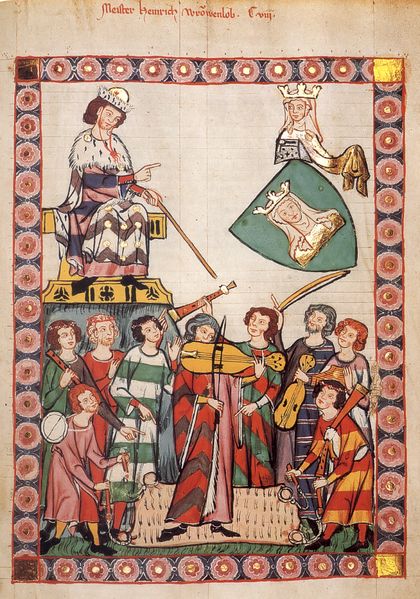
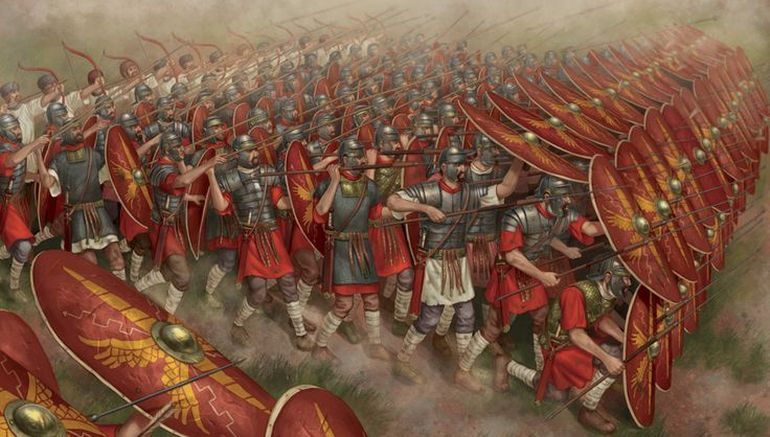

Pingback: A fantasy writer’s guide to … weaponry – Richie Billing
One thing I’ve always wondered is if someone wearing plate could fall down just right in a muddy battlefield, and get stuck there in the same way a large flat rock gets stuck laying in mud.
I’ve always wondered that too! Knights weren’t as immobile as people assum, though I can imagine in a quagmire it’d be tricky to get up. A possible source of conflict for a story, perhaps!
That would depend on a few things. Borrowed armor wouldn’t fit as well as a suit made for the wearer and wouldn’t be as well balanced, so someone in borrowed armor would be more likely to have problems moving in his armor. And when Mother Nature gets involved, even the best suit of armor can have problems. The tragedy of Azincourt, for example, occurred because of a poorly-chosen battleground that had flooded.
Great points. Lots of gear would have been looted. I can only imagine the pain of the chafing!
Pingback: A fantasy writer’s guide to … Castles and Keeps: part one – Richie Billing
Great article. I would be great to expand it with armor from other areas, Samurai armor, for example.
Thanks Chuck! Great idea. I’ll add it to my to do list 😉
It was my understanding that they quenched in oil, not water. This is further influenced/confirmed by the show “Forged in Fire” where the judges were a half step from putting their heads in their hands when a smith put his hot blade in water instead of oil to cool it down.
This is great! I’m writing a little in the Epic Fantasy genre and there were quite a few useful notes I wasnt aware of here. As a quick question, in film you see a lot of heroes and leaders not wearing helmets. Is this purely for cinematic effect or would some leaders remove their helmets to show their faces to their soldiers?
Thanks Benjamin! Delighted to hear you’re finding this useful. In the historical fiction books I’ve read, none of the heroes took off their helmets unless they were knocked off, or bashed in. They’re just too important defensively. So I’d say in films it’s more for cinematic effect and also for clarity so the viewer can see who’s doing what. Leonidas in 300, for instance, almost certainly wore a helmet in the battle with the Persians!
It may be apocryphal, but Harold Godwinson is said to have done just that at the battle of Hastings in 1066. As the battle continued through the day, a rumor grew that Harold had died or fled the field, I forget which. He took off his helmet and a Norman archer made a lucky shot that put out Harold’s eye and ended the battle.
It should be noted that, with the helmets of the time, it wasn’t necessary for Harold to take off his helmet, either to be seen or to get his eye shot out. But it makes a good story.
Pingback: The Life of the Medieval Lord - Richie Billing
Pingback: How To Create Your Very Own Living Breathing Fantasy World - Richie Billing
Pingback: Fantasy Races - The Ultimate Guide To Elves, Orcs and Dwarves | Richie Billing
Pingback: Killer Diseases of the Middle Ages | Richie Billing
Pingback: Medieval Cannons: The Essential Guide | Richie Billing
Pingback: On Writing: Fantasy Without Magic – Of Metal and Magic Publishing
Pingback: The Lives Of Medieval Peasants - Richie Billing
Thank you for sharing this valuable information. Your articles are always very informative.
I have a hard time describing my thoughts on content, but I really felt I should here. Your article is really great. I like the way you wrote this information.
Pingback: Fantasy Weapons - Medieval, Magic And Other Types - Richie Billing